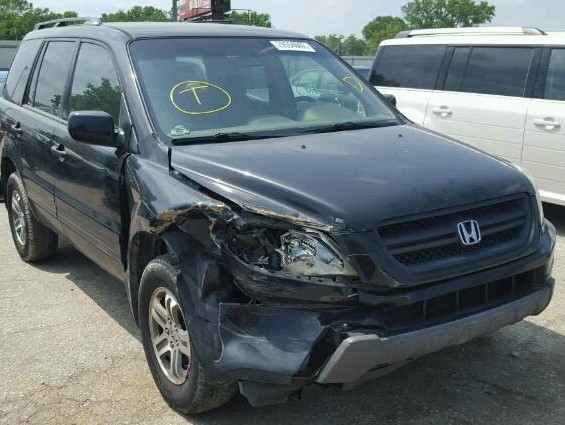
If I were a dog, I’d be the kind that’s easier to shave down than to groom. I wear the same clothes all week and often get past noon before I put on a bra or look in a mirror. I am a woman who, in a pinch, goes to the party with earrings that nearly match, betting no one will notice. I color my own hair even though, fairly frequently, the girls discover fist-sized gray sections in the back that I can’t see or reach. I never change filters or replace toothbrushes or stretch. My wanton disregard for maintenance of all types is what Edward was referring to when he “joked” that it was “on-brand” for me to proudly drive Big Blue.
Big Blue came into my life a few months before my daughter Claire did. Seven months pregnant with a second kid, it was time to upsize. We traded our VW Bug for a Honda Pilot. She was a beaut, Big Blue, until she wasn’t. It wasn’t two months before every crevice held the detritus of early childhood: Cheerios and rice cakes, bubble gum and boogers, Ziploc baggies, hair ties, granola bar wrappers, pointless pencils. (Also, because I often force it on the girls while I drive, lightly used dental floss.)
Edward stopped driving her and, after three or four years, launched a campaign to replace her, “while we can still get a decent trade in.” Short of disaster, my goal was to take Blue 150,000 miles. “Ten years, Eddy. That’s my dream.” Shortly after this conversation, Blue’s body was deflowered in an underground mall parking lot when I underestimated my distance from a car-eating concrete pillar striped with the paint of many previous victims. The dent on my door was deep but the car still locked and the window still went up and down so, functionally, Big Blue was uncompromised.
Not a week later, in the Safeway parking lot, a clean-shaven, outgoing man in a red truck drove slowly toward me, his arm hanging out the open window like he might want to shake hands. His truck was jacked up on beefy tires that spoke convincingly to his manhood. A sign on the side read: “Phil’s Body Work.” Phil offered to fix Blue’s dent while I shopped. I had never heard of such convenience. Had I just fallen into the perfect compromise for Edward, who “has standards” and didn’t want me “driving around town in a hoopty”?
“How much?” I asked.
“For you? $150,” Phil said. “There’s a cash machine inside the store,” he added, tipping his chin toward the Safeway.
“$150?” Edward estimated that a new door would cost $1,500!
“It’s worth it, Miss.” Miss? I felt so young, I nearly blushed. “You see right here?” He pointed to the gash in the center of the dent. “Next time it rains, water’s gonna stream right in there, and the locking and window mechanisms are gonna rust and now you’re talking about a whole new door…”
Phil was so wise, so foreseeing, so cheap. Edward would be proud of me.
“$150. Okay. I’m in.”
Pushing my cart toward the Pilot thirty minutes later, I saw that the dent had been suctioned out by Phil’s powerful magnet and the cut in the metal had been covered with gray speckled rust-protection material that from a distance looked like duct tape.
“Oh, so that’s how you do it, huh?” I said squinting at the patch and feeling idiotic for envisioning a factory-smooth door.
“That’ll protect your door for ten years, maybe more.” I counted out $150 into Phil’s open palm. Focus on the fact that it won’t rust, I planned to say to Edward.
“Are you kidding me?” Edward was not pleased. “You’re gonna leave it like that?”
“A new door costs thousands of dollars. I’m not spending thousands of dollars just to fix a three-inch nip.”
“It’s a six-inch gash, Kelly.”
“Tomato, tomahto.”
The following week, Edward brought home logo stickers from his new job at Medium. They were intended for the girls’ notebooks but I took one and centered it on top of the tape on my door. I thought it was clever.
A full ten years after we brought her home, Edward could stand Blue no longer. While I was back East taking the girls to camp, he traded her for babysitting hours from my young cousin Lena and bought a new Acura MDX “for me”.
Though I would have driven my banged-up, bumper-stickered baby until she sputtered to her death, I had to admit, the rearview camera immediately eliminated what I realized had been a decade of low grade anxiety. Would I be the suicidal woman dissolving on Oprah’s couch after backing over a toddler? I saw that episode; I didn’t forget it. On a lighter note, I reveled in the heated seats and the navigation system. I harbored ambitions to one day connect my IPhone to the stereo system by myself and listen to podcasts while I drove. Neighbors gaped at me in my pristine vehicle like I was Eliza Doolittle descending Henry Higgin’s staircase in fine silk.
Not long after, I was driving Claire and several of her teammates home from lacrosse practice in my still-new car and enjoying a bit of bliss; a car full of sweaty female athletes shouting Beyoncé lyrics is my rocky mountain high. At the third drop off, Claire waved goodbye to her teammate Sadie while I put the car in reverse. Using my clever rearview camera, I glanced at the lines projected on to the pavements and glided out until I heard the unmistakable sound of metal on metal. The vehicle rocked to a stop.
Nothing was visible to me; not another car, a kids’ bike, a lawnmower. I tried going forward. I tried reverse. I tried inching then gunning. Whatever I had hit, it was winning. I jammed the gear shift into park and got out to discover that my car was hooked on a fire hydrant, the front wheels on one side, the driver’s side door on the other. The front bumper was nearly torn off, hanging there like a plastic hairband bent to the break point.
As I hollered at the Gods in the language of the streets, Sadie stood in her doorway, eyes round, looking exactly like the emoticon for surprise. Her mother appeared behind her. They cringed in unison. In the back seat, a girl named Tina, a hundred pounds and speechless, stared straight ahead.
“It’s okay, Mom,” said Claire. “Right? It’s just a car, right?”
“Right. Oh God, right.” I coaxed a bit of sanity back into my expression. “Tina! Sadie! It’s fine. We’re good.”
While fire trucks screamed up the hill to dislodge my car, I bent over and smiled. How ridiculous. And who really cares? Well, other than Edward, who would be, shall we say, dispirited by history repeating itself so soon. I leaned in the window and said to Tina, “I don’t even like this car!” I did, of course. It was nice. But then, I didn’t either. Its flawless newness antagonized me. I angsted over the first spill. I didn’t need its smug meticulousness, its lack of personality, the way it defied nicknaming.
On the way home, with help from a no-nonsense guy at Valero, I zip-tied the bumper to a hidden bit of the car body, leaving just the tiniest gap to tell the story. Now, I had a car that reflected its owner: perfectly functional if secretly yoked together under the bumper. Wabi-sabi, the Japanese might call it.
“From here, you can’t even tell,” Claire said, standing back a few feet.
“I know, right?” I agreed.

Kelly Corrigan is the New York Times bestselling author of four books, most recently Tell Me More. This piece is excerpted from her earlier work. She will be speaking at The Claremont Country Club on Thursday, February 7.